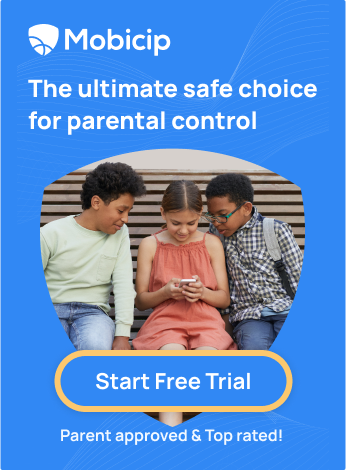How to Spark Healthy Tech Use in Kids: A Parent’s Guide

Seven years ago, we wrote this in an article on Digital Assimilation:
We are now so far into the digital age that many of us cannot remember life before it. The digital revolution, which historians say extended between 1950 and 1970, has changed life as much as the industrial revolution of the late nineteenth century did, or perhaps even more. The “revolution” phase may be considered to be officially over now, and we are at the stage of “assimilation”, which may continue for another century or so before the next revolution changes life yet again, hopefully for the better.
When beginning our discussion on fostering healthy tech use among kids, no other introduction seems more fitting than the one above. Today, technology is an integral part of our daily lives, shaping how we communicate, learn, and entertain ourselves. Children are immersed in this digital landscape from a remarkably young age. A staggering 83% of children aged 6 months to 6 years engage with screens daily, whether for play, learning, or reading. Understanding how to guide children in their digital journey is not just beneficial but essential in promoting their overall well-being and development.
This article shares practical strategies and insights to ensure children harness the positive aspects of technology while mitigating its potential risks. We will also see how Mobicip can work with parents and caregivers to foster healthy tech use among kids.
Is the use of technology and digital tools healthy for children?
The impact of technology and digital apps on children varies significantly based on their age and developmental stage. Research suggests that infants younger than 2 years old do not learn effectively from digital media. At this age, their understanding of what they see and hear on screens is limited, making direct interactions and physical experiences more beneficial for their development.
However, for children older than 2 years, some apps and e-books can aid in learning language and numbers, particularly when parents actively engage with them. Effective parental involvement includes highlighting key elements in videos, stories, or educational challenges to enhance the learning experience.
Educational apps are beneficial when they are age-appropriate, engaging, and have clear learning objectives. These apps encourage active participation rather than passive consumption, fostering deeper learning experiences. Conversely, apps with excessive interactive features like pop-ups and embedded games can distract children and hinder their ability to focus on essential content.
It must be remembered that prolonged exposure to digital media during preschool years is associated with increased risks of attention problems and difficulties with emotional regulation in children. Therefore, while technology can be a valuable educational tool, thoughtful selection and moderation are crucial to supporting healthy development in young children.
Thus, although digital tools can be helpful, we can only reiterate what Bard said: “Why, then, can one desire too much of a good thing?”
What is Digital Literacy/Media Literacy, and why is it important for Children and Caregivers?
Digital literacy/Media literacy refers to the comprehensive set of skills, knowledge, and attitudes that enable individuals, including children, to effectively navigate and utilize digital technologies and social media. It encompasses more than just technical competence; it extends to critical thinking, ethical behavior, and informed decision-making in digital environments.
At its core, digital literacy empowers children to understand the implications of their online actions, from privacy concerns to ethical considerations in digital interactions. It enables them to make informed choices about the content they consume, the communities they engage with, and the information they share online. By promoting digital literacy, parents and educators help children develop resilience against online risks such as cyberbullying, misinformation, and excessive screen time.
Moreover, digital literacy fosters a balanced approach to technology use. It encourages children to explore educational resources, develop creative skills through digital tools, and engage in meaningful online activities that complement their offline learning experiences. By integrating digital literacy into parenting and educational practices, caregivers can guide children towards leveraging technology for learning, creativity, and positive social interactions while mitigating potential harm.
Tips to Foster Healthy Technology Use in Children
Raising children in the digital age presents unique challenges. Sixty-six percent of U.S. parents believe that parenting is harder today than it was 20 years ago, often citing technology as a significant factor. The World Health Organization (WHO) recommends no screen time for children under 2 years old and only one hour per day for children aged 3 and 4. But children cannot indefinitely be shielded from technology and digital tools. It is up to the parents and caregivers to regulate children’s device use, balancing the need to limit screen time without completely restricting it, especially when devices may serve as vital social connectors during times like the pandemic. Some practical steps to foster mindful tech use in children include:
Healthy and open communication: Open communication is key to managing technology use among children. Talk to your child about their favorite apps and online activities. Discuss potential online risks, such as addiction, cyberbullying and privacy issues, and encourage them to come to you with any problems they encounter.
Setting Boundaries: Establish clear rules and guidelines for tech use. Set limits on daily screen time and designate tech-free zones, such as the dinner table or car. Avoid allowing screens in the bedroom at bedtime. Establish clear expectations and boundaries through a family agreement. Create a structured schedule that designates specific times for tech use, focusing on quality over quantity. Encourage meaningful online activities, like educational apps and creative projects. Tools like Mobicip can help set time limits and manage screen time effectively.
Monitoring Content: Set up parental controls to filter and restrict inappropriate content. Engage with your child’s online activities by watching media together and discussing the content. Mobicip’s content filtering and monitoring features can empower parents to oversee their children’s digital interactions. See the following section for how Mobicip can help you with this.
Identifying Underlying Issues: While there is much talk about excessive technology use causing depression and anxiety, the opposite could be true, too. Excessive tech use can sometimes indicate deeper issues, such as low self-esteem or social anxiety. Pay attention to your child’s emotional well-being and address any underlying problems that may drive their reliance on digital devices.
Encouraging Positive Tech Activities: Promote edutainment and subject-specific apps and sites that enhance learning and creativity. Encourage activities that use technology for good, such as digital volunteering or community projects. Utilize resources like Mobicip’s curated list of educational apps to find suitable options.
Encouraging off-screen activities: Encouraging non-tech related activities is essential for a child’s balanced development, offering numerous benefits that screen time cannot provide. Outdoor play, for instance, promotes physical health, motor skills, and an appreciation for nature. Visiting museums, parks, and historical sites enriches children’s knowledge and cultural awareness, fostering curiosity and a love for learning. These activities also provide opportunities for social interaction, helping children develop crucial social skills and build meaningful relationships. By engaging in various offline experiences, children can not only have digital detox time but also explore their interests, develop creativity, and gain a well-rounded perspective on the world, all of which are vital for their overall growth and well-being.
Modelling Healthy Tech Use: Children often emulate their parents’ behaviours. Demonstrate responsible tech use by managing your screen time and respecting digital privacy, such as asking for photo consent. Show how tools like Mobicip can help monitor and guide online activities, reinforcing safe and responsible tech use.
How Mobicip can help
Mobicip can play a vital role in fostering healthy tech use among children by providing parents with the tools and resources needed to guide and monitor their digital interactions. As children are increasingly exposed to digital devices, parents must ensure that their tech usage is safe, balanced, and beneficial to their development. Mobicip offers a comprehensive suite of features designed to help parents achieve this goal.
One of Mobicip’s primary functions is its robust content filtering system, which allows parents to block inappropriate websites and apps, ensuring that children only access age-appropriate content. This not only protects them from harmful material but also helps them focus on educational and constructive activities. By filtering out distractions and potentially dangerous content, Mobicip helps create a safer online environment for children.
In addition to content filtering, Mobicip provides detailed activity reports, giving parents insights into their children’s online behavior. These reports can highlight how much time kids are spending on different apps and websites, allowing parents to identify patterns and address any excessive or unhealthy tech use. Understanding these patterns can help parents have informed conversations with their children about responsible tech use and the importance of balance.
Mobicip also offers screen time management features, enabling parents to set daily limits on device usage and schedule screen-free times, such as during meals or before bedtime. These controls help ensure that children do not spend excessive time on screens and encourage them to engage in offline activities, promoting a healthier balance between online and offline life.

Mobicip’s app-blocking capabilities allow parents to restrict access to certain applications during specific times of the day, such as school hours or family time. This ensures that children remain focused on their studies and participate in family interactions without the constant distraction of their devices.

Another significant advantage of Mobicip is its focus on collaboration between parents and children. The platform encourages parents to involve their children in setting up rules and understanding the reasons behind them. This cooperative approach helps children develop a sense of responsibility and ownership over their tech habits, leading to more sustainable and self-regulated behavior.

By leveraging Mobicip’s features, parents can create a structured and supportive digital environment that nurtures healthy tech use. This proactive approach not only protects children from online risks but also empowers them to use technology in ways that enhance their learning, creativity, and social interactions. Through careful monitoring, effective communication, and setting clear boundaries, Mobicip helps parents foster a positive and balanced relationship between their children and technology.
Take Away
Digital literacy is crucial in regulating tech use in children because it equips them with the skills and knowledge to navigate the digital world safely and responsibly. Fostering healthy tech use in children requires a balanced approach that includes setting clear boundaries, modeling positive behavior, encouraging outdoor activities, and maintaining open communication to ensure technology enhances rather than detracts from their overall well-being.
FAQs
How Much Screen Time Is Healthy?
Determining healthy screen time varies by age and individual needs. The American Academy of Pediatrics (AAP) suggests that children under 18 months should avoid screen time except video chatting, while those aged 18-24 can engage in high-quality programming with parental guidance. For children aged 2 to 5 years, screen time should be limited to one hour per day of high-quality content, and parents should co-view to help children understand and apply what they see. For children aged 6 and older, consistent limits should be placed on screen time to ensure it doesn’t interfere with sleep, physical activity, and other healthy behaviors. Each family is different, so it’s essential to create a balanced plan that works for your household while ensuring children have time for other important activities.
What About Social Media?
Social media can be a valuable tool for connection but also presents risks, especially for children and teens. It’s crucial to ensure that your child adheres to age guidelines, as most platforms require users to be at least 13 years old. Teach your child how to use privacy settings to control who can see their posts and personal information, and discuss the importance of thinking before posting, as digital footprints are lasting. Encourage respectful and kind interactions online, discuss the impacts of cyberbullying and how to handle it if it occurs, and maintain open communication about their online experiences. Regularly monitor your child’s social media use to stay aware of their interactions and ensure they navigate the digital world safely.
How Can I Balance Tech and Outdoor Activities?
Balancing technology use with outdoor activities is crucial for overall well-being. Set clear limits on screen use and outdoor activities by creating a family media plan with specific guidelines. Model healthy behavior by limiting your own screen time and prioritizing outdoor activities, and consider using technology to enhance outdoor experiences, like using apps for nature exploration or geocaching. Plan regular family outings to parks, hiking trails, or sports activities and make these events part of your routine. Support your child’s interests in outdoor activities by providing the necessary equipment or signing them up for related clubs or classes. Additionally, establish tech-free zones in your home, such as the dining room and bedrooms, to encourage physical play and interaction. Balancing tech and outdoor activities helps promote a healthier lifestyle and can foster a love for the outdoors.






